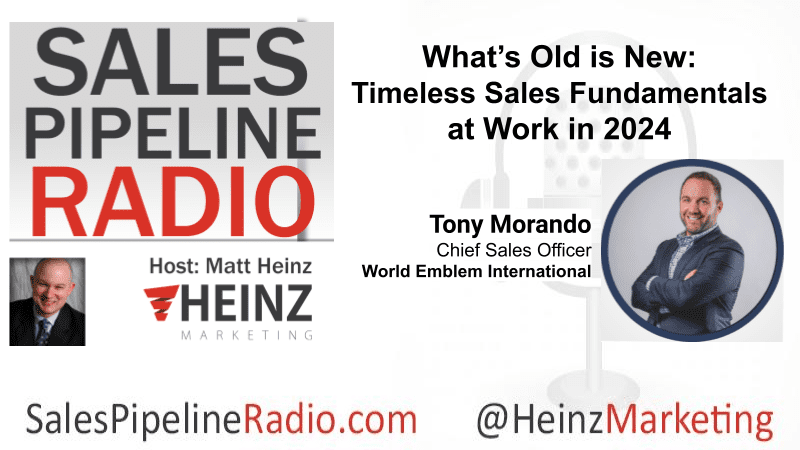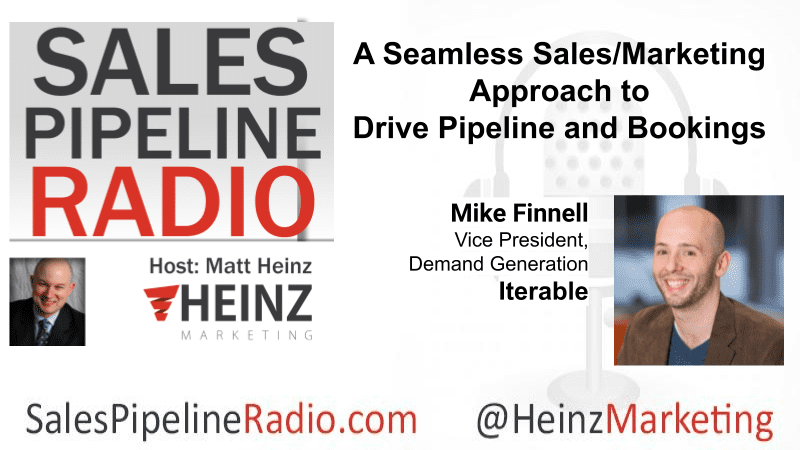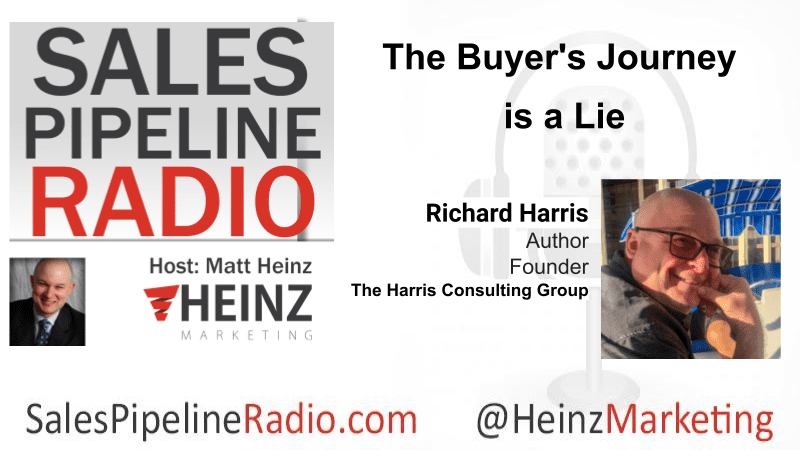Sales Pipeline Radio, Episode 336: Q & A with Domenic Colasante

By Matt Heinz, President of Heinz Marketing
If you’re not already subscribed to Sales Pipeline Radio or listening live every Thursday at 11:30 a.m Pacific on LinkedIn (also on demand) you can find the transcription and recording here on the blog every Monday morning. The show is less than 30 minutes, fast-paced and full of actionable advice, best practices and more for B2B sales & marketing professionals.
We cover a wide range of topics, with a focus on sales development and inside sales priorities. You can subscribe right at Sales Pipeline Radio and/or listen to full recordings of past shows everywhere you listen to podcasts! Spotify, iTunes, Blubrry, Google Play, iHeartRADIO, Stitcher and now on Amazon music. You can even ask Siri, Alexa and Google or search on Audible!
This week’s show is entitled, “How to Build & Scale the Human Side of Marketing“ and my guest is Domenic Colasante, CEO at 2X.
Tune in to hear more about:
- The evolution of the marketing function and how people are sourcing that work
- How successful companies are thinking about increase in maturity and complexity of technology
- The talent gap and maturing needs of organizations relative to people process, tools, and media
- What are the things that should be outsourced to agencies?
Watch the video, listen in below and/or read the transcript below.
Matt: All right, welcome everybody to another episode of Sales Pipeline Radio. I’m your host, Matt Heinz and I am so excited to have you here. I was wearing just a polo shirt earlier, Dom, and then I had to put on a jacket because the last two days, it was the beginning of spring here, in Seattle. But we are back to winter for today, cold and rainy. But it doesn’t deter us at all, we keep going. I’m excited that you’re all here.
If you are watching and listening live on LinkedIn, I am very excited that you’re here with us, in the middle of your workday, taking a break from some March Madness and we appreciate it very much. If you are joining us live, you have the ability to be part of the show. If you have a question, if you have a comment, I know Dominic, you’ve got some people from your team that are on with us live for cheering and all the above. Feel free to throw a question or a comment into the LinkedIn comments. We might bring your comment up on screen. We might ask your question live on air. So, thanks very much for joining us, and if you’re watching or listening on demand, thank you so much for downloading and listening. Every episode of Sales Pipeline Radio, l think 400+ episodes, past, present, future, always available on salespipelineradio.com. Very excited to have joining us today, friend, partner, a leader in the B2B marketing space, Dominic Colasante. He’s the CEO of 2X Marketing. Dominic, thanks for joining us.
Domenic: Thanks for having me, Matt. I can’t think of a better way to spend 2:30pm. This is great!
Matt: I appreciate that. Like I said, we try to make these 15-20 minutes long. My new tagline is, if we can get you to the grocery store and back, and you listen to the whole episode, you’re good to go. But no, appreciate you joining. When we were brainstorming topics of what to cover here, cause there’s so much we could do, it kind of came down to this idea of how to resource B2B marketing today. Cause the job has changed, the role has changed, and it almost seems like this counterintuitive… there’s a lot of people available today. There’s too many layoffs happening amongst companies as we record this. And yet it’s getting, harder and harder for people to hire the right roles internally. I’d love to hear a little bit about what you’re seeing in the market, both in terms of the evolution of the marketing function, as well as how people are sourcing that work.
Domenic: Yeah, you know, it’s funny, I used to be a CMO before, and so I lived in the chair of many folks who I think are grappling with this problem today. And when you used to ask marketers about transformation, it’s we want to do some innovation. We want to transform, we want to change how marketing runs, the things that they most often talk about. A couple areas they talk about are technology and the different tech stacks they can bring in and the different new platforms. Even today, on the AI side or other types of platforms, usually the conversation on innovation is around technology or sometimes it’s around the way that we spend our program dollars where all the marketing budget goes out the door, making that more efficient, right?
Or sometimes it’s around reporting metrics and how we track and measure marketing results and changing the three letter acronyms to other things. Very seldom does anyone talk about marketing transformation with respect to the organization, to the humans, to the people that do the work all day. And I think that’s part of what puts us in this moment right now, where we’ve been innovating as marketers for 10 years on so many pieces of marketing, but we’ve not really innovated on the organization, innovated on the humans, the talent, the people that do the work every day. And frankly, it’s where marketers spend sometimes more than half of their budget and more than half of their time, trying to build that organization. And so, I think it’s been an area that’s never had a lot of attention and is one of the issues.
I think second is, things have changed really fast. We look at… it took 10 years or more to get everyone to understand demand generation and how to do that. And there was huge amounts of investment and effort around trying to skill marketers that come out of college, mostly generalist marketers into being B2B focused, which very few schools will teach, and then into demand gen oriented, which no one will teach. And so a lot of them have learned that in the work world. And then in the last couple years, the entire game has changed – different technology, different processes, different best practices, different books have been written, and I just don’t think there’s been enough attention on skilling the workforce up as that shift has occurred.
Matt: I would agree. And I’ve heard, especially in the last six to eight months, you talk to a lot of CMOs and they’re under budget pressure and they think about if they’re going to simplify it, it’s programs and people, and I would argue, if you’re going to further differentiated it, you’ve got all sorts of media, you’ve got tools, you’ve got people, and the investments in the tools have appropriately gone up significantly over the last, you know, 8-10 years. But I think too many companies still think, okay, I’m going to buy these tools and they’re just going to work themselves. I’m going to buy all these tools, and it’s going to automate stuff. I’m going to buy tools, and it’s going to mean I need fewer people to go and do things. That’s a recipe for failure for a lot of organizations. So, talk a little bit about how some of the more successful companies are thinking about the increase in maturity and complexity of technology and what that means for the people and resources they need to make them work.
Domenic: Yeah, I completely agree, and I think that every technology project, technology implementation is, is way bigger than just a technology. It’s a change management initiative. It’s updating, how your company runs and how the processes come to life, and how you do marketing in your core DNA. And the human element of that, I look at when you’re budgeting a technology investment, you need the budget, and some human investment to go with it. Most people are pretty good at budgeting for the implementation of it and the services around that. But then what happens after? How do we use it all day? And as much as we would love everything to automate everything, um, ERP didn’t put the accountants out of work, they’re still here. And I think there’s a lot in the marketing tech space, a lot of similar parallels where the tech makes us better, but we still need people to use it.
I think that there’s a couple past practices that I look at where folks really understand how to do that. One is they think really thoughtfully about what work do you need to do in your organization versus what work could you buy from the outside? And back when I was a CMO and other marketer friends of mine, we would sort of tell this narrative, and I think it was true for a little bit, that marketing is so special and sacred that only we can do it. That it has to be in sourced, it has to be full-time people in our headquarters building with a whiteboard nearby because we need to be innovating and collaborating in person. And the last couple years, a lot of that’s changed. Hybrid work, digital work, has become the norm.
Marketing is still very productive even though it’s not in the same location and I think the job of marketing has changed. One, there’s certain things in the org where you need to become the best in the world at it, things that only you can do. Right. And there’s probably 60 to 70% of the things that marketers do where you just want to implement the best practice, you just want to follow the best way of doing something. And there’s so much different technology and innovation going on that it’s hard for you to stay up to date on all those new areas and to constantly be in best practice. And so, actually in those areas, I think it’s, it’s much more appropriate to consider purchasing those labor skills capabilities from the outside and consuming them based on the outcomes they produce, rather than trying to run on that house wheel even faster and try to create those talented individuals – skill them, certify them, retain them – and be able to manage an organization that is, is inherently in rapid change.
Matt: Talking today on Sales Pipeline Radio with Dominic Colasante, he’s the CEO of 2X Marketing. We’re talking about things related to the talent gap and sort of maturing needs of organizations relative to, people process, tools, and media. There was a thread, I was just looking for it over here on my slack screen, amongst a bunch of CMOs talking about what are the things that you outsource? What are, where do you to consistently outsource things to sort of agencies and consultants? And some of the common things that came up, as you expect, were PR, SEO, and some content. And I was really surprised that I didn’t see rev ops or marketing operations, more actively on there. And I wonder if it’s because people think, okay, well that’s a core thing. I need to do it internally. But then I think about at least, and you probably have a better answer to this way, I think of at least four areas. If you’ve got any level of MarTech tools, whether you just have a standalone Marketo, or whether you have a truly integrated stack, there’s implementation, there’s integration with other tools, there’s operating that tool to make it work on a day-to-day basis. And then there’s ongoing optimization to continue to bring in best practices, right? Today’s innovations is tomorrow’s broken status quo. So, what are some of the functions to make rev ops work well that people may be forgetting or underserving or under resourcing today?
Domenic: I think you hit the nail on the head with the last one. Using the technology and optimizing it and running it as if, you know, it’s part of the DNA of the York is the thing that always gets forgotten, right? It’s all the efforts spent on implementation and integration and setting it up, but then someone’s got to use it and things change and evolve. Your company launches new products, you make acquisitions, and you decide to pivot in different areas and focus on areas where there’s pipeline gaps or new sales teams and the world changes. The day you implemented and go live is the day it starts to go out of date. And having an organization or a team to support that is such a critical piece, and I think is often missed. The way I look at it, when marketers have been outsourcing things for some time, marketers tend to look at it that they’re going to outsource either big projects at a point in time where you have a burst of activity needed for something that you don’t have resourcing for, or very edge case specialized. Things like PR, like SEO, like SEM that require very experienced and technical resources to do those things. But then there’s all the stuff in the middle, like the day-to-day caring and feeding of the marketing org. In some ways it’s hard to have generalists do that anymore because there’s so much tech involved. There’s so much process involved, there’s so many different pieces involved.
I’ve done some research with the team at 6sense around trying to measure this skills gap in the market. We looked at a real-time supply and demand of talent. We said, let’s go on LinkedIn, let’s look at all the job posts that are open. Let’s look at all the keywords associated with them, things that are related to B2B marketing, new age, things like intent like ABM, like AI, like 6sense or other and then let’s look at who has a LinkedIn profile that has those keywords. And so we were almost able to get a real-time view of demand for what positions are being recruited for versus supply of which people have those roles. And we found fascinating things that for all the new age stuff, there’s not enough talent available, which I think we all felt, but to put some numbers around it, we found some of these things like Marketo, would be another, where you find, for every one position posted, there’s really only one resource. So, 4,000 positions, 4,000 people, like a 1:1 ratio of positions posted and people that have the skill, by the way, most of those people are employed already. So, you can argue huge sorts there. When you look at something that’s more mature email content events, you have a 20:1 ratio of people that have the skill versus how many positions are open. And I think that tells us that there’s not enough people that understand how to do those things, which is really in the center nucleus of how every marketing org operates today.
Matt: So, I want to talk a little bit about how this gets done because I think there’s a lot of companies doing some different things around this. Companies looking to sort of offshore talent to do this. And I want to honestly debunk some things that we learned that maybe some people think about that is, you don’t get the same level of talent if you’re offshoring or if you don’t have an integrated team because you’re halfway around the world and don’t have the hours integrated. A couple months ago, we hired our first, BDR as an organization. He’s a gentleman from the Philippines. And I’ve been pleasantly surprised and impressed at how well integrated he has become. And just the level of highly educated, highly motivated, highly capable people all around the world, with technology, with the innovations we have today, make it so much easier for teams to coalesce together. We would love for you to sort of share a little bit more about sort of what you’ve seen on that work, because I know you’ve got teams doing this highly successful, very seamless integrated way.
Domenic: Yeah. At 2X, the company I’m fortunate to lead, we’ve got 500 people in Koala, Lumpur, and Malaysia servicing clients in the US market. 500 people who are B2B, new age marketers providing a lot of those skills I mentioned that are in shortage in the US. And I think that it’s important to recognize that, one, it’s a global world. It’s a global talent pool. There is talent available in many places around the world that you can seamlessly bring into your organization, in ways that maybe hadn’t existed before. It’s important to recognize that your competitors are doing that, and so they’re able to pull talent from markets where you may not be if you’re not operating a global operating model. And there’s also some interesting things around economics that come from that.
Two, I think marketing outsourcing and outsourcing in particular that has been done in the marketing space, is probably more often done incorrectly than it’s been done correctly. I think it’s really important to appreciate that. B2B marketing is very different from B2C and the kind of skills, capabilities, technology, and best practices that you have that B2B marketing, even if it’s not a role related to writing and communications, English proficiency, is very important. I think up until recently there hasn’t been firms that have really prioritized creating talent pools that could be accessible to a US B2B marketer via an offshore market that prioritizes B2B, prioritizes English proficiency and prioritizes this new age marketing mindset with the technology stack at the core of it, until recently. And so now those firms exist like 2X, that are able to support organizations. I’m going to really able to almost off-ramp them from this talent whiplash that we’ve had from the great resignation, then the war for talent, and then the big downsizing and layoffs and now not enough people to do the work. B expanding your talent acquisition strategy to a global model you almost get an unfair advantage of you’re not fighting over the same people in the US market. We found in the resources that we have offshore, equivalent skillset, many more certifications and 70% less on the economic. And it’s hard to really, unsee it once you’ve experienced that and really appreciate that a lot of marketing work can get done in a very different way.
Matt: Well, and it’s not just economics, right? I think a lot of people think, “oh, if I outsource this, then it’s going to be that much less expensive” is Yes. Yeah. Currently you can outsource things in Southeast Asia and you know, dollar for dollar you’re going to get, you’re going to pay less. However, I think that is one of many benefits and maybe a secondary benefit to the idea that you have some continuity on your team. You have people that are motivated and loyal who are going to stick around. You have people where, I mean, our purpose as a business is to positively impact careers and lives by enabling work that matters. And I’ve seen firsthand through our BDR, through the administrator of a professional organization I’m in, that’s in also in the Philippines. I mean, it’s like she’s working our hours. She might as well, I mean, you might as well be across the country. Across the world is like next door if we’re working mostly through Zoom. It’s just the level of professionalism and seamlessness. It condenses the world in a way that you think about the unlimited potential that creates, and when you can break down those barriers and especially say, we can do this in a seamless way. We can do this with highly educated, motivated people where it seamlessly integrates the organization with some continuity that has, I mean yes, economic aside, that is also pretty exciting stuff.
Domenic: Yeah. I’ll give you another point on the continuity too, in that, so many organizations and marketing leaders in particular spend a huge amount of their job maintaining, hiring, and replacing talent. And so they’re sort of on this constant cycle of vacant roles and interviewing. And I have, one of our clients had a problem with Marketo talent. They had this revolving door of Marketo talent, and they could never keep Marketo people in the job. And so, and the problem is, if those Marketo people weren’t there, they weren’t doing marketing, they weren’t sending email, they weren’t automating their engine, they weren’t routing leads, things like that. And so, one of the great things about bringing on a vendor versus trying to do it yourself is, if a vendor has a resource turnover, they’re accountable to give you a new resource, they’re going to overlap. They’re going to find the new person, they’re going to train that new person, they’re going to drop that new person in. It’s almost like you remove yourself from having to worry about replacing and retaining talent. And there’s a lot of roles in the organization, frankly, that marketers really need that are very important, that are individual contributor roles that sometimes just don’t have a career path. Folks particularly, that are highly motivated, really experienced, high energy people want to come and do those jobs and they want to be promoted up or promoted out in some something else. But you need stability in those roles. And it’s really hard when you’re running your org to make sure those people always have interesting things to work on and you’re trying to stretch them, and you end up spending all this time trying to develop that talent. That’s an important thing to do as a, as a human being. But sometimes it’s difficult to do as a leader when you just need the emails to be tested, you just need the stuff to be routed, you just need the data to be integrated, just need spreadsheets cleaned up and pulled. You just need that execution work to be stable and sustainable. And another way to get out of the business of having to worry about that is to have someone do it for you and provide a service around it.
Matt: Totally agree. Well wrapping it up here with Dominic Colasante, the CEO of 2X Marketing. I’ll put a couple links up to some work that he’s done. Go to 2x.marketing to check out some of that great blog and see some of his research with 6sense as well. I mean, I don’t see this debating, Dominic. I think, you know, as we record this you know, there’s sort of this weird talent crunch of finding the right people. I think it’s getting harder and harder to find the right people, the right price here in the US but even as we get into, past the current economic conditions into a more, I guess maybe sugar rush area, era of the market, again, I think that’s just going to exacerbate this problem. It’s going to get more people hiring, more people looking for the same people, while more companies are now being expected to do more, as they go about that. And so, I think that in terms of asking you about, what do you see moving forward, curious, does that align with what you’re seeing or what are you experiencing with your clients?
Domenic: Yeah. If you know, that’s exactly right. I look at the current environment, a little bit of austerity, a little bit of, hesitation to do things, A little bit of concern around making big bets and hiring and transforming it’s current environment. We’re in, in some ways looks very similar to what we saw in the back half of 2020. There was a different thing going on that caused that, but it was the same amount of hesitation and caution in making decisions. What we know is what happened in 2021 after, which is everyone sort of came out of the groundhog, Paul, and said, time to invest in marketing, because the solution to most problems in business are more revenue. And if we dial down, dial up the marketing lever and spend more money on marketing and drive more activity, we’re going to have more results.
And that wave is coming. That’s what follows these waves that we’re in right now. And the problem is, when that wave comes, you’re going to have another war for talent. You’re going to have another great resignation when people are going to move around and recruiting agencies are going to tell everyone they can get 30% more by changing jobs and you’re going to have more instability. And I think this really time, this problem’s not going away. There’s no one really working on developing talent of the future in the B2B new age marketing world. It’s not going to go away. And so, I think the only choice is to think about in this moment, how do you change the operating model? How do you build a better structure, where you de-risk yourself from some of those labor dynamics and build something that’s more flexible, agile, cost effective, and gives you access to talent that you don’t have. That’s the only choice you have right now, I think.
Matt: I would agree. And for companies that are sort of saying, “well, you know, we’re resource constraint.” Well, we’re going to or have to watch where we are. Companies that succeed out of markets like this are those that accelerate through the curve and the ones that accelerate through the curve have higher, better confidence in their plan moving forward. And many times, that means they’re doing scenario planning right now. So, if you assume that in the second half of this year or in 2024, whatever your timing is, you’re going to want to hit the gas pedal on your business, in your market, in your industry. You can mash your teeth about where things are now, or you can be ready when your CFO says go. And so highly encourage everyone, to start thinking about what is it going to take if we’re asked to accelerate results, what is it going to take from a people, from a program, from a process standpoint? And just be ready for that. So, Dominic, I know people can find you on LinkedIn, 2x.marketing, learn more about the business, get a lot more of your content. Where else should people check you out?
Domenic: That’s it. LinkedIn and our website. That’s where you find me most often.
Matt: Clean and simple. All right. Well thank you everyone for joining us today. Thank you to Scott, to Nick, to Maria, to a number of others that are watching, listening, chiming in. We’ll be here again next week, 11:30 Pacific, 2:30 Eastern. Thanks again to our guest, Dominic Ante for joining us today. My name is Matt Heinz. We’ll see you next week on another episode of Sales Pipeline Radio. Take care.
Listen to the Latest Episodes:





